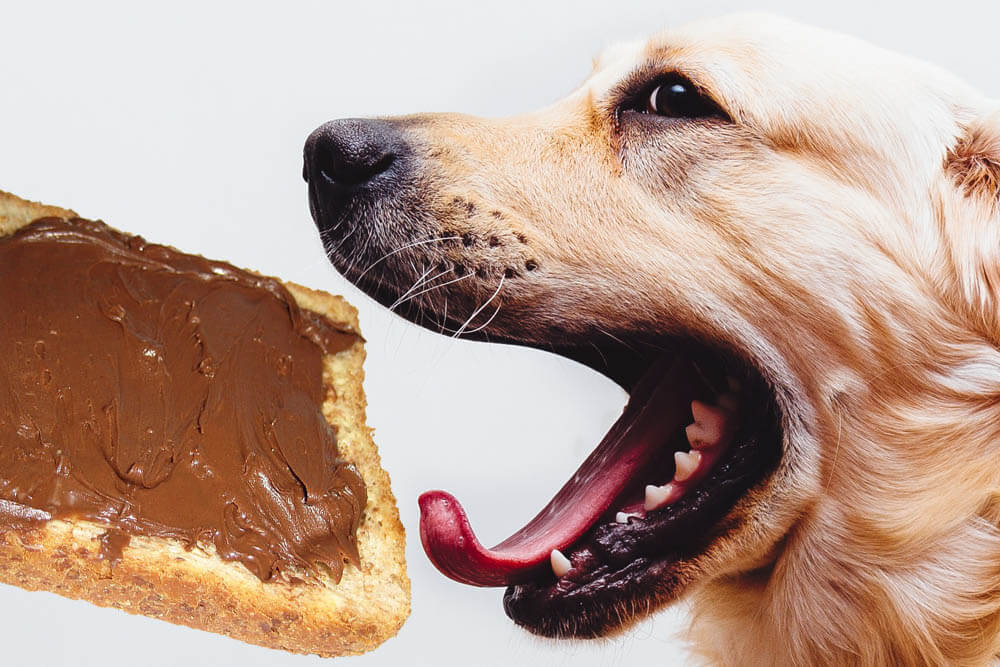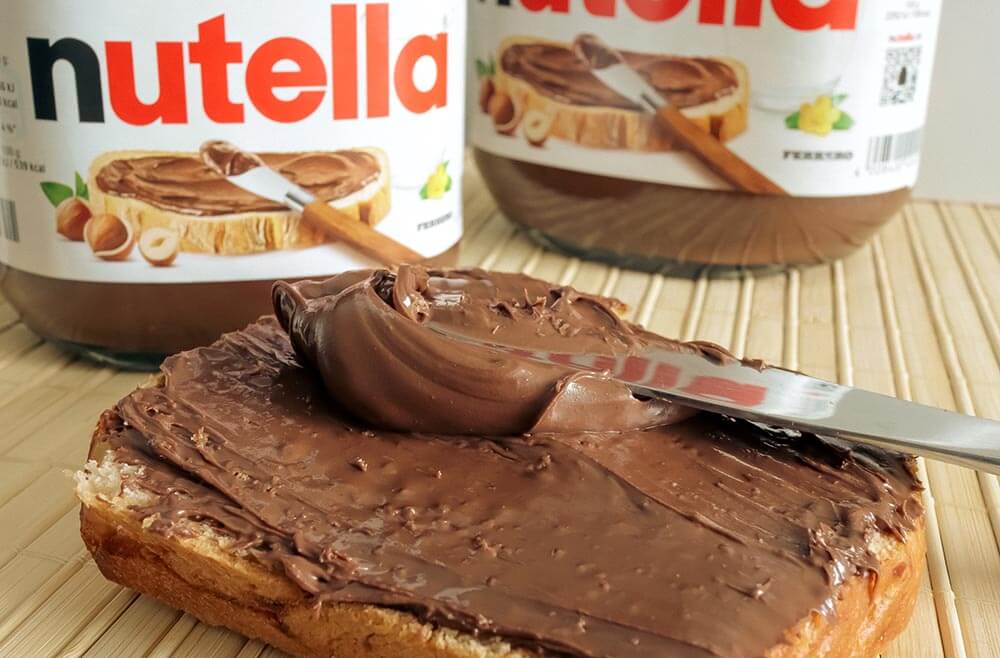Sweet heaven in a spoon! Nutella’s mouthwatering goodness has earned it a special place in everyone’s heart. And shouldn’t something so precious be shared with those you love?
If you have to share your Nutella, share it with another human.
It’s not recommended for dogs to eat Nutella. In fact, it’s better not to give your dog Nutella at all. This spread contains ingredients that won’t benefit your pet; some can even be toxic if ingested in large amounts.
Read on as we discuss why Nutella can be bad for dogs.

What is Nutella?
The world-famous Nutella is a delicious hazel cocoa spread. Its main ingredients are sugar, palm oil, hazelnut, cocoa, and skimmed milk. The ingredient list may vary depending on the country.
While Nutella is usually spread on slices of bread, it can also be used as an ingredient or filling in various foods, including cakes, custards, and ice creams.
Nutella is manufactured by Ferrero, an Italian company known for other sinfully addictive delights such as Ferrero Rocher and Kinder Surprise egg.

Why Nutella isn’t dog-friendly
Nutella is lacking in the nutrients crucial to your dog’s health. It’s extremely low in protein, for instance. And while it contains vitamins and minerals, your dog can obtain greater amounts of such nutrients from healthier foods.
As for the other ingredients, some of them are useless to your dog, while the rest can harm your dog if a lot is eaten. A dog fed Nutella may therefore experience the following issues:
Poisoning due to theobromine
Chocolate is a deadly toxin to dogs because it contains a substance called theobromine. Being a cocoa-based food, Nutella also contains theobromine.
While Nutella may not have enough theobromine to kill your dog, it can still make them ill especially if eaten in large amounts. Don’t forget to take your dog’s size into account; a tiny amount of theobromine for a large dog may be deadly for a small dog.
If a dog gets poisoned after consuming a lot of Nutella, they may experience diarrhea, nausea, vomiting, increased urination, anxiety, depression, hyperactivity, excessive panting, a poor appetite, stomach pain, and dehydration.
The frequent and/or surplus consumption of Nutella may result in serious theobromine poisoning, which can cause the above symptoms as well as internal bleeding, tremors, epileptic seizures, an irregular heartbeat, a heart attack, and even death.
Poisoning due to caffeine
Caffeine is another substance that’s toxic to dogs. It can affect the gastrointestinal tract, resulting in vomiting and diarrhea. It can raise blood pressure and cause cardiac arrhythmia (irregular heartbeat), which can endanger your pet. Worst of all, it can kill your dog if consumed in overabundance.
Other symptoms of caffeine poisoning include extreme thirst and urination, excessive panting, tremors, and seizures. Symptoms may be observed within 1 to 2 hours of caffeine ingestion.
Like theobromine, caffeine is only found in trace amounts in Nutella, so a teaspoon of the spread is unlikely to cause your pooch serious harm. Nevertheless, it can still make your dog experience milder symptoms of caffeine ingestion. And, as previously discussed, your dog’s size will determine how much Nutella is too much.
Thanks to its high fat and sugar content, too much Nutella can make your dog gain unnecessary weight and even become obese.
A severely overweight dog has trouble managing even the lightest of physical activities, which, in turn, causes even more weight gain. Obesity also increases the risk of heart disease and diabetes – serious medical conditions that can shorten your dog’s lifespan.
In short, obesity hurts your dog’s health and quality of life.
Blood sugar imbalance
Eating Nutella frequently is equivalent to consuming a surplus of sugar, which raises your dog’s blood sugar levels. This can cause dehydration, extreme thirst, depression, lower energy levels, seizures, or even a coma.
Having elevated blood sugar levels for long periods can increase the risk of many medical problems, including kidney disease, heart disease, stroke, and possibly even diabetes.
Pancreatitis
The pancreas allows your dog’s blood sugar levels to normalize. Unfortunately, consuming great amounts of food as sugary as Nutella forces the pancreas to work extra hard to achieve the same effect. This can lead to pancreatic inflammation or damage a.k.a. pancreatitis.
A dog with pancreatitis exhibits symptoms such as nausea, vomiting, diarrhea, dehydration, depression, abdominal pain, poor appetite, lethargy, and fever. If left untreated, this condition can cause death.
Loss of appetite
If you frequently feed your dog Nutella, they can become addicted to its sugary sweetness. A sugar-addicted dog may end up favoring sweet treats over healthier options, which can ruin their diet and, consequently, their health.
Digestive problems
Overindulging in a high-fat, high-sugar treat such as Nutella can result in digestive issues such as an upset stomach, a stomachache, gas, diarrhea, and vomiting.
Dental issues
When your dog eats sugar, the bacteria in their mouth produce acid to break it down. Therefore, the frequent and/or excess consumption of Nutella – a food high in sugar – raises the mouth’s acidity level. Over time, this can damage the enamel (the hard outer surface of the teeth). The result? Painful, possibly infected cavities that can culminate in tooth loss.

Protecting your dog
There are measures you can take to keep your dog safe from the problems that may arise from eating Nutella.
Tiny serving size
Once more, we don’t recommend feeding dogs Nutella. Even a small amount can upset your dog’s stomach or worse.
However, if you insist on sharing this treat with your pooch, it’s important you don’t serve them any amount larger than a teaspoon. A small-breed dog should be given even less. A large dog may be able to eat up to two teaspoons. You can mix this tiny amount into your dog’s food to give it a touch of new flavor.
Don’t feed your dog Nutella every day. It should be eaten as sparingly as possible.
Out of sight, out of mind
Dogs are curious creatures. If they see or smell something delicious, they’ll be tempted to take a bite out of it. For this reason, don’t leave any Nutella jars out in the open; hide them in cupboards above the kitchen counter or anywhere else your dog can’t see and reach them.
Read ingredient labels
As of writing, Nutella doesn’t contain an artificial sweetener called xylitol. However, many sugar-free foods use this substance.
Xylitol is highly toxic to dogs. Don’t give your dog any food with xylitol.
Look out for other artificial sweeteners, too. Some, such as stevia and erythritol, won’t hurt your dog as long as they’re eaten in small doses.
Should the day come Ferrero creates a sugar-free Nutella variant, make sure it doesn’t contain xylitol.
Preparation is a lifesaver
Learn the symptoms of poisoning and the other health problems eating Nutella can cause. This will help you determine whether or not a dog that’s eaten Nutella needs medical treatment.
Familiarize yourself with the address and phone number of the nearest, best vet in your area. This information should be stored in your phone and written down where it can be seen by everyone in your family.
Those in North America can also contact the Pet Poison Helpline at (855) 764-7661 or Animal Poison Control at (888) 426-4435 should any problems arise.
Seek veterinary assistance
Should you observe any problems in your dog after they’ve eaten Nutella, call a vet for advice on what to do next. A dog exhibiting severe or prolonged symptoms should be taken to the vet immediately.
Always ask a vet for advice about the food you give your dog. Let them know if you plan on having your pet try anything new. As much as possible, only feed your dog vet-approved foods.

To conclude…
It doesn’t make much sense to feed dogs Nutella. Not only does it lack the nutrients your dog needs but it also contains substances that can make canines ill.
For such reasons, your dog is better off not eating any Nutella. Which should be good news, as it means more Nutella for you!
